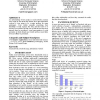BCSHCI
2008
14 years 2 months ago
2008
In this paper, we describe the design and evaluation of SMART, an educational system that uses augmented reality for teaching 2nd grade-level concepts, adequate and integrated wit...
BCSHCI
2007
14 years 2 months ago
2007
This paper reflects on the design value that emerges from evaluation methods used in the field of child computer interaction. The work is based around an evaluation study of a tan...
BCSHCI
2008
14 years 2 months ago
2008
As HCI embraces experience design, it will increasingly rely on new elicitation methods that are capable of drawing out the multi-faceted subjectivities of individuals without bei...
BCSHCI
2008
14 years 2 months ago
2008
Personas are a powerful design and communication tool to help all those involved in the creation of interactive systems to better focus their efforts on their users. A persona is ...
BCSHCI
2007
14 years 2 months ago
2007
In this paper we discuss how information technology impacts erotic life. This has been a neglected issue in most of the literature, even the literature on IT in the home. We argue...
BCSHCI
2007
14 years 2 months ago
2007
This paper presents the design and comparison of a mousebased interaction technique (hereafter IT) and two advanced IT, used in public spaces to support navigation in a 3D space. ...
BCSHCI
2008
14 years 2 months ago
2008
An understanding of how people in social networks consume news media by and about their friends shows that information overload is soon going to be a major problem for many partic...
BCSHCI
2007
14 years 2 months ago
2007
The history of technology, as a discipline, supports alternate points of view termed internalist and externalist, which terms highlight an approximately similar division in points...
BCSHCI
2008
14 years 2 months ago
2008
At the Human Computer Interaction Lab (HCILab) at UNC Charlotte, we investigate novel ways for people to interact with computers, and through computers with their environments. Ou...
BCSHCI
2007
14 years 2 months ago
2007
This poster describes work being undertaken in the use of pervasive computing for the treatment of mental health problems. The use of technology to help patients with psychologica...





